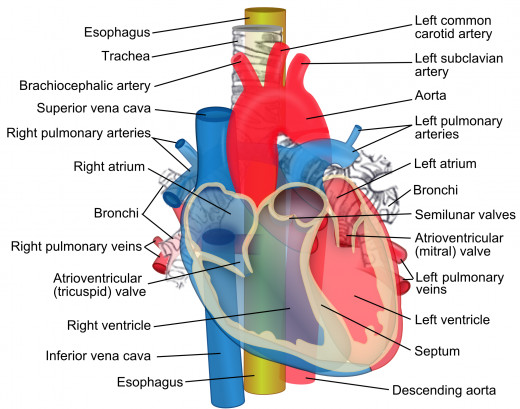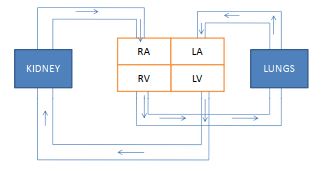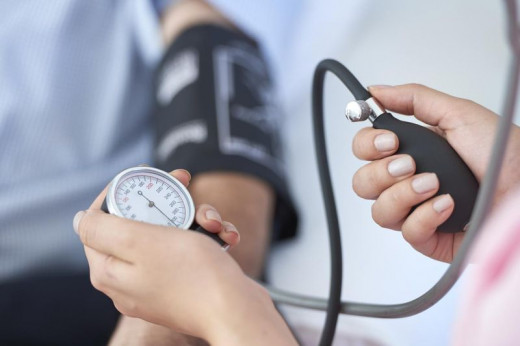Hypertension

Facts about hypertension
The heart is about 4.8 inches in length and 3.35 inches wide.
• Pumps about 2000 liters of blood each day.
• The wall of the heart chamber is composed of cardiac muscle tissue
called myocardium.
• The septum between the atrial chambers is called interatrial
septum.
• The septum between the ventricles chambers is called
interventricular septum.
• Each chamber is lined by a thin chamber called endocardium.
• Inflammation of this chamber is called endocarditis.
• The heart is covered by a layer called pericardium.It consists of
parietal and visceral layers with lubricating fluid in between.

The cardiovascular system is an enclosed system comprising of the heart and blood vessels.
• The left ventricle is thicker then other chambers that umps blood to aorta and supplies oxygenated blood to the body.
• All arteries carry oxygenated blood except Pulmonary artery.
• All veins carry deoxygenated blood.
Hypertension is an important medical and public health issue.
• There is a direct relationship with hypertension and cardiovascular
disease.
• It is estimated that 1 billion people are suffering from hypertension.
• Hypertension is sustained elevation of BP
Systolic blood pressure >= 140 mm Hg
Diastolic blood pressure >= 90 mm Hg
Risk factors for hypertension
- Aging (men >55 years and Female >65 years)
- High sodium intake contributes to high blood pressure and causes
- High Alcohol
- Smoking
- Elevated Cholesterol
- Family history‐ (men <55 years and Female <65 years)
- Diabetes Mellitus and Insulin Resistance
- Adrenal, Thyroid and Renal Problem
- Low potassium intake
- Low Calcium intake
- Obesity
- Stress
Blood Pressure Classification
Classification
| Systolic pressure mmHg
| Dyastolic pressure mmHg
|
|---|---|---|
Normal
| <120 and
| <80
|
Pre‐Hypertension
| 120‐139 or
| 80-89
|
Stage I
| 140-159 or
| 90-99
|
Stage II
| ≥160 or
| ≥100
|
Symptoms of Hypertension
There's a common misconception that people with high blood pressure will experience symptoms such as Nervousness, Sweating, Difficulty Sleeping or Facial flushing.
If you ignore your blood pressure because you think symptoms will alert you to the problem, you are taking a dangerous chance with your life.
HBP (high blood pressure) is largely a symptomless condition.
Severe Hypertension Symptoms
- Headache
- Visual Disturbance
- Angina
- Palpitations
- Nausea and Vomiting
- Difficulty breathing
- Dizziness
- Fatigue
- Edema
Diagnosis
Screening
- For Conformation measure Blood Pressure for 2 times at different occasion
- Clinical symptoms (Non or Headache, Visual disturbance)
- Family and past medical History
secondary cause of Hypertension
- Renal function Test
- ECG
- Complete clinical biochemistry
- Full Blood Count
- Electrolytes level
- Thyroid and other endocrine Test
Prevention of High Blood Pressure
- Stopping smoking
- Exercising regularly
- Losing weight
- Eating a healthy diet
- Cutting down on salt and Caffeine
- Limit the alcohol
AntiHypertensive Drugs
-
Calcium channel blockers
-
Beta blockers
-
Diuretics
-
ACE Inhibitor
-
Alpha 1 blockers
-
Vasodilators
-
Angiotensin receptor blockers
-
Centrally acting drugs
Calcium channel Blockers
These category divided into two groups
1. Acts on myocardial muscle (used for the treatment of Angina )
- Varapamil
- Diltiazem
2. Acts on Blood vessels
- Nifedipine
- Falodipine
- Amlodipine
Beta Blockers
Acts mainly on the β receptors.
Drugs used for this category are :
- Hypertension‐ Atenolol, Metoprolol
- Arrhythmia-Sotalol, Ismolol
- Heart failure‐ Metoprolol, Bisoprolol, Carvedilol
- Hyperthyreidism‐ Propanolol
- Glucoma‐ Timolol, Betaxolol
- Anxiety‐ Propanolol
Diuretics
Diuretics are drugs that increase urine production in the kidneys and promote the removal of salt and fluid from the body.
Thiazide Diuretics :
- Thiazide Diuretics are used for first line treatment for the non‐comorbid Hypertension cause the excretion of sodium and potassium ion and the retention calcium ion.
- Thiazides are not recommended for the patients of diabetes.
- Thiazide + Beta‐ blockers causes impotency and decline in libido
- Due to the side effect of Hyperuricemia it is not use for the patients
of gout. - Not used for the sulfa allergic patients.
Loop Diuretics :
- Furosamide , Bumetanide ,Ethacrinic acid used for edema and not for hypertension.
- Loop diuretics reduce all the electrolytes from the body and are
prescribed to be taken in the morning.
Potassium sparing Diuretics :
- Amiloride,
- Indapamide
Spironolactone has the anti androgenic effect and Eplerone is used
to treat heart failure.
ACE Inhibitors
Angiotensin converting Enzyme Inhibitors
- These are the first line treatment for the Hypertensive patients suffering from Diabetes also used in the patients of heart failure as a first line treatment.
- ACE inhibitors are not considered to be suitable for pregnant woman..
- Drugs involved in this category are : Ramipril, Lisinopril, Analapril, Captopril
- It is a first line treatment for Angina.
- The most commonly used drug of this class is Ramipril.
- It is a cardiac remodeling drug and also used for the management of Left ventricular Hypertrophy.
Alpha 1 Blocker
- Drugs included in this category are Prazosin, Terazosin.
- It is a good medication for Benign Prostate Hypertrophy.
- Used for hypertension.
- Alpha 1 blockers are considered to be vasodilator medication.
Vasodilators
- The drugs included in this category are Hydralazine,Minoxidil.
- Minoxidil is used nowadays for the treatment of hairloss.
- Side effects : SLE ( Systemic lupus erythematosus) People with slow acetylation process develop SLE.
Centrally acting Drugs
- The drugs used in this category are alpha methyl‐dopa, Clonidine.
- alpha methyl‐dopa is the most recommended drug for pregnancy.
- Clonidine is used for drug addiction and for non hormonal
manopause system management.
Risk Factors and complications
• Obesity
• Smoking
• Increased cholesterol level
• Stress
• Alcohol consumption
• Sedentary situation
• Family history
• Stroke
• Cardiovascular disease
• Eye problems
Secondary cause of hypertension
- Renal impairment
- Cushing’s syndrome
- Hyperaldosteroidism
- Pheochromocytoma

This content is accurate and true to the best of the author’s knowledge and is not meant to substitute for formal and individualized advice from a qualified professional.
© 2019 pratik987








